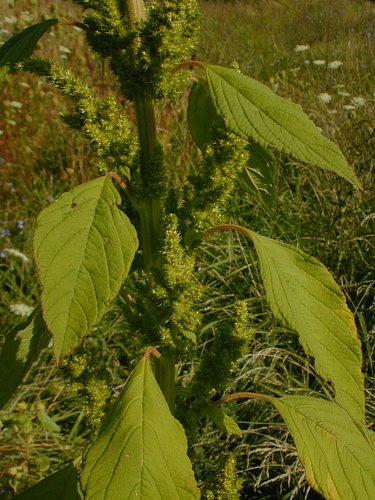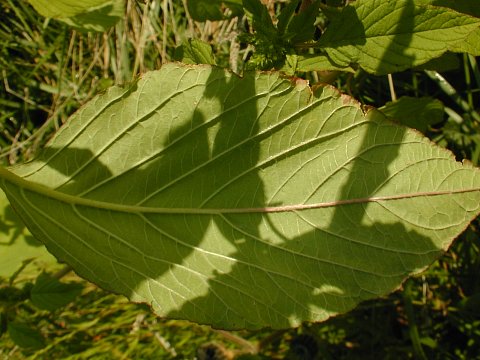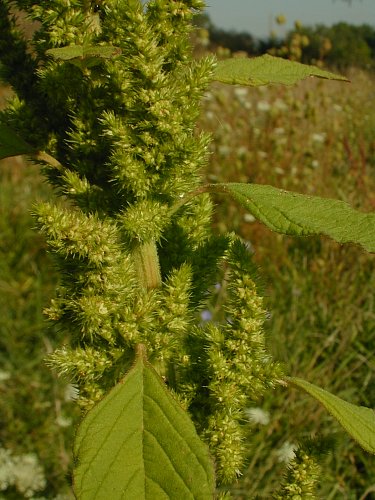Description: This plant is a summer annual about 2-6' tall. It is unbranched, or branches occasionally. The central stem is light green or tan-green, round in circumference, ribbed, and usually hairy; sometimes the lower portion of this stem is hairless. The alternate leaves are up to 5½" long and 3" across (excluding the petioles), becoming slightly smaller as they ascend the central stem. They are ovate or elliptic-ovate, smooth or slightly undulate along the margins, and pubescent or hairless. The lower side of each leaf has elevated pinnate veins. The uppermost leaves are smaller, lanceolate, and pubescent. This form of Slender Pigweed has predominately green foliage, although their may be red tints along the margins of the leaves and elsewhere. The petioles are quite long, causing the leaves to droop downward somewhat; they are often pubescent like the stems.

The upper stem terminates in an elongated panicle of spikes with small green flowers. This panicle is up to 2' long on large plants. From the axils of the upper leaves, there develops panicles of spikes or simple spikes of flowers that are much shorter than the terminal inflorescence. The individual spikes have a bristly appearance because of the linear bracts surrounding the flowers. Slender Pigweed is usually monoecious with staminate and pistillate flowers on the same plant. Each type of flower has 5 cream sepals and no petals. The sepals are about 2 mm. in length and oblong with short pointed tips. Each staminate flower (male) has 5 stamens, while each pistillate flower (female) has an ovary with 3 styles. Each type of flower is surrounded by several green bracts that are about 3-4 mm. long and linear with long pointed tips. The blooming period occurs during late summer to early fall and lasts about 1-2 months. The flowers are wind-pollinated. Each flower is replaced by a seed that is contained in a bladder-like membrane (utricle). This utricle becomes tan and splits apart to release the seed. The small seeds are flattened, dark brown or black, circular, and shiny. They are produced in great abundance on a robust plant. The root system consists of a taproot that is short and stout; it is often tinted red. This plant spreads by reseeding itself.

Cultivation:
This
plant typically occurs in full sun, mesic conditions, and a loamy soil
with high nitrogen content. However, it is adaptable and can be found
in gravelly soil, clay-loam, and moist to dry areas. The size of
individual plants is highly variable, depending on soil fertility and
moisture amounts. The seeds can remain viable in the soil for eat least
30 years.
Range & Habitat:
The non-native Slender Pigweed is a common plant that has been observed
in most
counties of Illinois (see Distribution
Map). The green form of this
species is more common than the red form (the Distribution Map
combines observations for both forms). It is originally from
South America. Habitats include weedy meadows, cropland, fallow fields,
farm lots, vegetable gardens, gravelly areas along railroads, and waste
areas. Highly disturbed and degraded habitats are preferred.

Faunal
Associations:
Insects rarely visit the wind-pollinated flowers. The caterpillars of a skipper, Pholisora catullus (Common Sootywing),
feed on Slender Pigweed (Amaranthus hybridus), as do the caterpillars of several moths, including Spilosoma virginica (Virginia Tiger Moth) and Papaipema nebris (Common
Stalk Borer Moth). Other insects that feed on this plant include
Disonycha spp. (flea beetles), Epicauta vittata (Striped Blister
Beetle), Empoasca solana (Southern Garden Leafhopper), and Phenacoccus
solenopsis (Solenopsis Mealybug). The Insect Table has a more complete list of insects that feed on Amaranthus spp. (Amaranth,
Pigweed). The
seeds of amaranth and pigweeds are an important source of food for the
Greater Prairie Chicken and granivorous songbirds, including the Horned
Lark, Lark Sparrow, Field Sparrow, and Mourning Dove. The Bird Table
has a more complete list of these species. Pigs and cattle eat
pigweeds readily, although the foliage can cause bloating and other
symptoms of nitrate poisoning if an excessive amount of the foliage is
eaten (Georgia, 1913). White-tailed Deer browse on pigweed to a minor
extent, spreading the seeds to new locations (Myers et al., 2004).
Photographic Location:
A weedy meadow at Judge Webber Park in Urbana, Illinois.

Comments: This is the common green form of Slender Pigweed. Contrary to the scientific name, this species is not a hybrid, although it can hybridize with Amaranthus retroflexus (Rough Pigweed). These two species of Pigweed are both from South America and they are fairly difficult to tell apart. In this regard, a 10x hand lens can be helpful. Generally, the flowering spikes of Slender Amaranth are more green and slender than those of Rough Pigweed; the flowering spikes of the latter are whitish green and rather stout. The floral bracts of Slender Pigweed are about 3-4 mm., while the floral bracts of Rough Pigweed are about 4-6 mm. long. The sepals of Slender Pigweed usually have pointed tips, while the sepals of Rough Pigweed have tips that are more flattened. Rough Pigweed is generally more short and stout in its growth habit, and it is usually no more than 3' tall. Another common name for Amaranthus hybridus is Green Pigweed, but the foliage of this species is sometimes red.